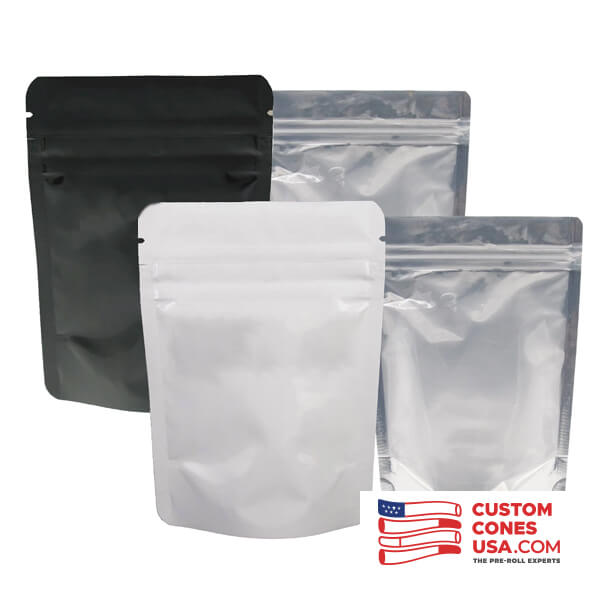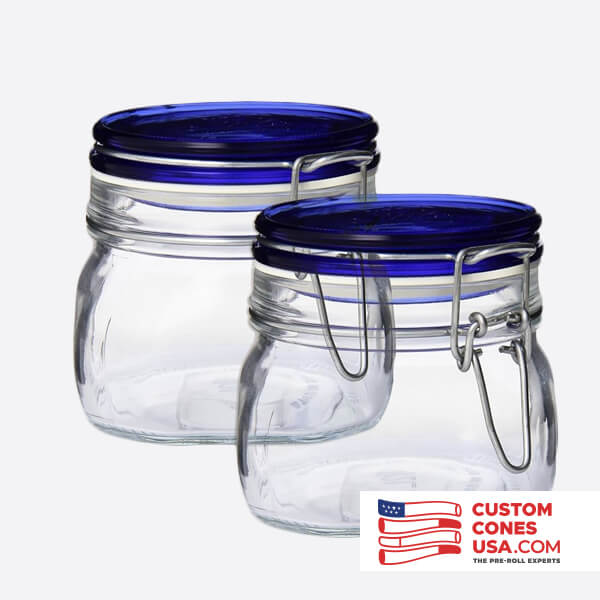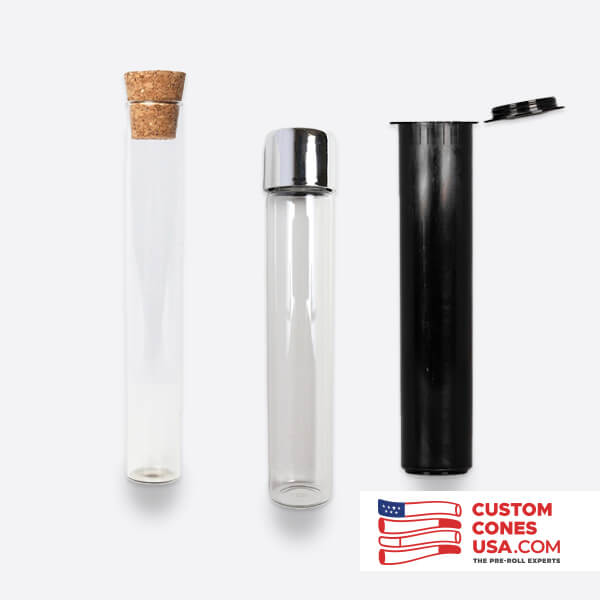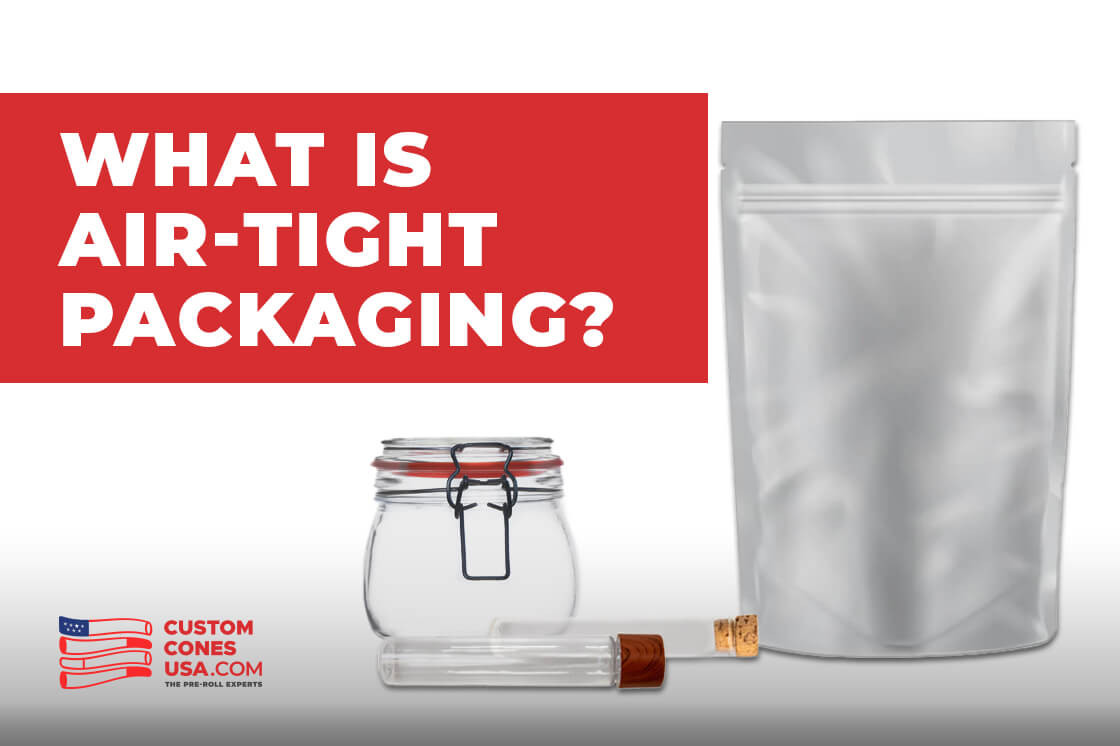What is Airtight Packaging?
Posted by Custom Cones USA on Dec 7th 2023
As the cannabis industry and pre-roll sector in particular continue to evolve, the next trend that will dominate the industry is a move toward keeping the product fresh, so it’s at its most potent and flavorful state when the consumer gets it home.
For producers and pre-roll manufacturers, that means staying focused on the latest trends in both humidity packs and, perhaps most importantly, on airtight pre-roll packaging to ensure that the product your packing is as good being smoked as it is coming off the pre-roll production line.
Why is airtight pre-roll packaging important?
In the food industry, it’s easy to see why keeping your product sealed tight is important: if you don’t, the food goes bad, gets stale or begins to grow mold. It’s gross, and no one is going to buy it.
But in the cannabis industry, it’s just as important to keep air from reaching your flower or pre-rolls, but the effects are not as easily seen, so a customer may not realize the pre-roll has gone bad and just assume your product is not very good. And that’s no way to create brand loyalty.
While it may not necessarily grow mold (though it can), cannabis, like a food product will degrade if exposed to oxygen. Studies have found that when cannabis is exposed to oxygen, a reaction at the molecular level causes the plant’s cannabinoid structure to change. When oxidized, THC converts to CBN. A U.N. study from 1999, for example, found that after one year, the ratio of CBN to THC increased by 2.5%. After two years, it increased by 6.7%, rising to 14.2 after four years.
With shoppers often focused on potency, this could cost you customers if your pre-rolls don’t provide the high they expect by reading lab results from when your flower was fresher.
On top of a drop in potency, exposure to air can simply dry out the flower in your prerolls, causing them to burn quicker and creating a less user-friendly experience. Moisture also affects the potency, flavor and aroma of cannabis flower.
This is because cannabinoids and terpenes – which give cannabis strains their characteristic aromas and flavors – are created in the trichomes, the sticky tube-like structures that grow on the surface cannabis plants. When exposed to air that’s too dry, trichomes can dry out, become brittle and break off, leaving the flower without any of the components modern cannabis consumers seek out.
In addition, terpenes themselves are part a class of molecule known as “volatile organic compounds,” which means they evaporate at around room temperature, so exposure to air can cause your flower to lose some of its punch, wasting the effort and time you put into growing a top shelf, highly aromatic product.
On the other hand, air that is too humid can cause problems in the other direction, even causing mold to grow on and around your pre-rolls.
So put simply, exposure to air during storage means worse-tasting, less potent and faster-burning pre-rolls. Which means fewer smokers returning to buy your product a second time.
What does "Airtight" really mean?
The solution, of course, is to ensure your pre-roll packaging is airtight so the oxygen does not affect the product. But what exactly does "airtight" mean?
By simple definition, “airtight packaging” means packaging designed to keep any air from transferring in or out of the packaging, but interestingly enough, there is no official standard for “airtight” packaging. There are, however, codes and standards for "permeation testing," primarily for pharmaceutical products, which ultimately test whether or not moisture and air can find their way into or out of a storage container.
Most of the tests measure water vapor transmission. They involve placing dry moisture-sensitive beads inside the packaging and then submerging the packaging underwater for various periods of time. The packaging is weighed at the beginning of the experiment, as well as at various points during the experiment, to determine if the beads absorbed any water and therefore increased in weight.
The nonprofit organization United States Pharmacopeia (USP), for example, has a standard that can used to classify containers as “tight” if they pass a strict vapor transmission test and is also capable of tight reclosure or "well closed" if they meet the same standards, but cannot necessarily be re-closed as tightly.
Types of airtight pre-roll packaging and processes


Many different types of closures and caps are available for cannabis packaging, from the ubiquitous mylar bag to plastic pop-pop doob tubes to glass jars and tubes with screw caps, child-resistant caps and cork.
All will provide some level of protection from air and moisture, though the capabilities of each are different.
For example, glass, unlike plastic, is "basically impermeable" and will better protect cannabis and pre-rolled joints from exposure than a plastic tube will, though that is dependent on the cap. Cork, for example, provides a level of protection to the product inside, but is ultimately permeable and will allow for transfer of air without further sealing.
A screw top will provide a better, longer lasting seal for a glass pre-roll tube than cork, particularly with another seal or insert underneath between the tub and the top of the cap, though the more they are used, the less likely they are to seal tight.
Pop top plastic tubes, on the other hand, are surprisingly airtight even without additional underseals, and because of their hard plastic nature, remain airtight even after repeated openings and closings.
A truly airtight seal is called a "hermetic seal." Named for the Greek god Hermes and coming from old alchemist writings, a hermetic seal is often used in sealing electronic components like batteries and usually involves removing the air from the product, often with a vacuum tube.
For example, the original U.S. Constitution and Declaration of Independence are kept in glass containers that are filled with argon and hermetically sealed in order to keep them safe from the elements, which would degrade and eventually destroy the parchment on which they’re written.
In the cannabis industry, there are some brands that vacuum pack their products, usually their flower, replacing the air in the packaging with nitrogen to ensure the product stays safe and fresh as it sits on shelves.
Is cork or a cap more airtight for pre-roll packaging?
One of the earliest methods of sealing off packaging is with a cork, which can be compressed enough to slide into the top of a tube or bottle, but then expands to fill the entire space and create a seal. However, while cork does create a strong seal that will prevent some air and moisture transfer, it is not airtight and the product will degrade over time.

The modern world, thankfully, provides for better options than cork, such as screw tops, silicone or even the plastic pop-top packaging.
A classic aluminum screw-top option will create a seal, but the better options for those looking for an airtight option is to go with one of the child-resistant push-and-turn seals with a thin plastic disc that forms a seal over the top of the tube to create an airtight seal.
Silicone caps also provide another level of protection against oxygen degradation because, like cork, they are squeezed to fit and then expand fit the space. But unlike cork, silicone is less permeable.
And, of course, the plastic pop top doob tube, which features a very tight closure is, for all intents and purposes, airtight.
Pop Top Tube Testing
At Custom Cones USA, we conducted our own airtight test on several plastic tubes, using a method found in the USP 671 protocols.
We placed water-absorbing beads inside the tubes, weighed them dry, closed them and put them in a humidity-controlled environment. We followed a strict regiment of opening and closing the containers and then weighing them every few days to see which ones absorbed water from their environment.
What we found surprised us. You might think that because they are a cheaper option, plastic pop-top tubes will not protect your pre-rolls from the elements, but our testing found that our J-line plastic pop top tubes with their rigid, tight-fitting tops, are, in fact, airtight, earning a "tight" rating under the USP standards, even after multiple openings.
Airtight Pre-Roll Packaging Additions
One of the easiest ways to help maintain the proper vapor level inside any pre-roll packaging is to add a humidity pack as part of your packaging, particularly in pre-roll multi-packs that are opened and closed repeatedly.
Keeping the humidity levels inside your packaging will ensure that your flower stays as fresh as possible and is as good when lit as it was when packaged.
Another addition that can help block both water vapor and air transmission is the addition of plastic overwrapping or a heat-shrink to seal out air during storage and transport, though in both cases, once the package is opened those seals are no longer effective.
Light Degradation in Pre-Roll Packaging
In the cannabis industry, while air and the moisture in it is the largest problem, light degradation can also be an issue as exposure to UV rays – such as those through a clear, glass tube – can also affect the product and cause a drop in THC percentage, converting it to CBN.
Because of that – and because some states require it – opaque packaging and opaque pre-roll tubes are also a favorite among pre-roll manufacturers. Though again, choosing the right cap to protect against oxygen degradation and moisture transfer is going to be key in ensuring your customers get the best version of your product that you can provide in order to keep them coming back to your brand.
As the cannabis industry and pre-roll sector in particular continue to evolve, the next trend that will dominate the industry is a move toward keeping the product fresh, so it’s at its most potent and flavorful state when the consumer gets it home.










